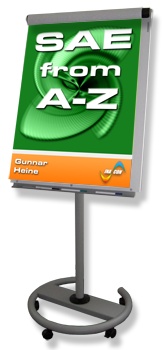 SAE / EPC from A-Z
SAE / EPC from A-Z
[2-day course, Euro 2,350.- (net) per participant]
Assessment & Top Level View

- Why is an Architecture Evolution necessary?
- Important Requirements on SAE according to 3GPP
- Comprehension Check & Exercise:
- Reasons of a System Architecture Evolution?
- Comprehension Check & Exercise:
- Seamless Mobility Options and their Characteristics
- Intra-RAT Mobility, Inter-RAT Mobility (w/o Optimizations), Inter-RAT Mobility (with Optimizations)
- Architecture Overview
- Evolved Packet Core in Context
- EPC vs. EPS, Non-3GPP Access Networks (trusted / non-trusted)
- Zoom into the EPS
- Functional Overview of Core Network Elements within the EPC)
- Network Elements and their Functions within the EPC
- Mobility Management Entity (MME) (Characteristics (Identification), Interfaces & Protocols (Tasks & Functions of the MME), Serving Gateway (S-GW) (Characteristics (Identification)), Interfaces & Protocols, Tasks & Functions of the S-GW), PDN Gateway (P-GW or PDN-GW) (Characteristics (Identification)), Interfaces & Protocols, Tasks & Functions of the P-GW), enhanced Packet Data Gateway (ePDG) (Characteristics (Identification)), Interfaces & Protocols, Tasks & Functions of the ePDG), Protocol Stack Architecture on the UE-Side
- Comprehension Check & Exercise:
- Interworking within the EPS-Architecture
- Evolved Packet Core in Context
 Operations Overview
Operations Overview
- Network Access to the EPC in case of 3GPP-RAT's
- E-UTRAN
- Related Network Architecture (Related Network Elements), Signaling and Important State Changes (EMM, ECM, ESM)
- GERAN / UTRAN
- Related Network Architecture (Selection of EPC vs. GGSN), Signaling Procedures (GMM/PMM, SM), Comprehension Check & Exercise:
- Relate E-UTRAN Procedures to GERAN / UTRAN Procedures
- E-UTRAN
- Network Access in case of Non-3GPP RAT's
- Network Discovery and Selection
- Problem Description, Interworking with the ANDSF, Distinction Trusted vs. Non-Trusted Non-3GPP RAT's
- Trusted Non-3GPP RAT's
- Related Network Architecture, Signaling Procedures if EAP and PMIPv6 are used, Signaling Procedures if MIPv4 is used
- Non-Trusted Non-3GPP RAT's
- Related Network Architecture, Signaling Procedures if IKEv2 and PMIPv6 are used, Signaling Procedures if IKEv2 and DSMIPv6 are used
- Network Discovery and Selection
- Voice Call Establishment
- IMS-based
- Related Network Architecture, Signaling Procedure (SIP, SDP, DIAMETER)
- Circuit-switched Fallback
- Related Network Architecture, Signaling Procedure for MOC, Signaling Procedure for MTC, Comprehension Check & Exercise:
- Voice Call Establishment
- IMS-based
- Macro Mobility / Inter-RAT Roaming
- Handover E-UTRAN to Trusted Non-3GPP RAT
- Related Network Architecture, Signaling Procedure (NBM / PMIPv6 on S2a), Handover E-UTRAN to Non-Trusted Non-3GPP RAT, Related Network Architecture, Signaling Procedure (NBM / PMIPv6 on S2b), Comprehension Check & Exercise:
- Inter-RAT Mobility
- Handover E-UTRAN to Trusted Non-3GPP RAT
 Architectural Details of the EPS
Architectural Details of the EPS
- Comprehension Test & Repetition:
- Network Interfaces and Protocols
- Network Layout and Important Identifiers
- Organization of the E-UTRAN
- Tracking Areas, TAI and TAI-list, E-UTRAN Pool Areas, MME Pool's and MMEI
- S-GW Service Areas
- Identifiers of the UE
- M-TMSI and S-TMSI, GUTI
- Organization of the E-UTRAN
- Bearer Concept & QoS-Architecture in SAE
- SAE-Bearers, Classification and Policy Enforcement
- The QoS-Profile of the SAE-Bearer
- GBR - Guaranteed Bit Rate, MBR - Maximum Bit Rate, AMBR - Aggregate Maximum Bit Rate, ARP - Allocation Retention Priority, QCI-Values and their Meanings (Mapping between Rel. 8 QoS and earlier Releases), QoS-Architecture with Release 8 (PCRF (Policy and Charging Rules Function), BBERF (Bearer Binding and Event Reporting Function), PCEF (Policy and Charging Enforcement Function), AF (Application Function), SPR (Subscription Profile Repository), OCS (Online Charging System), OFCS (Offline Charging System)
- Bearer Establishment & Authorization - Differences Rel. 8 vs former Releases
- Relationship and Dependency among the different Bearers
- Security Architecture
- Overview & Introduction
- Essentials, EPS-AKA, Security is performed independently in two protocol layers, Algorithms
- Operation of UMTS-AKA
- Key Derivation Function (KDF)
- Comprehension Check & Practical Exercise:
- The KDF S(10) for K(ASME) (Input Parameters)
- EPS-AKA in Operation during Initial Attach Procedure
- Overview & Introduction
 Protocol Suite
Protocol Suite
- The “Mainstream” Protocol Stacks
- Control Plane / E-UTRAN - EPC
- User Plane E-UTRAN – EPC (S5/S8 GTP-based)
- User Plane E-UTRAN – EPC (S5/S8 PMIPv6/GRE-based)
- Generic Protocols within the EPC-Environment
- IPv4 and IPv6 and their Differences
- Headers and IP-Address Ranges, How to obtain an IP-Address (IPv4 and DHCP, IPv6 and “Stateless Autoconfiguration”, Real-Life Recording: Stateless Autoconfiguration), Fragmentation in IPv4 and IPv6
- QoS in IP-Networks
- DiffServ (Details of the AF(X,Y) PHB (Assured Forwarding), Details of the EF PHB (Expedite Forwarding))
- SCTP
- Important SCTP-Functions, Example of an SCTP-Packet
- DIAMETER
- IPv4 and IPv6 and their Differences
- Protocols related to E-UTRA Networks
- EPS Mobility Management (EMM)
- Important EMM-Procedures (Common Procedures, Specific Procedures, Connection Management Procedures), State Machine (Relationship between EMM and ECM)
- EPS Session Management (ESM)
- Important ESM-Procedures (MME-initiated, UE-initiated), State Machine
- Radio Resource Control RRC
- Overview (Transmission of broadcast information, Establish and maintain services, QoS control, Transfer of dedicated control information), State Characteristics of RRC (RRC_IDLE, RRC_CONNECTED)
- Packet Data Convergence Protocol (PDCP)
- Overview (RoHC, Numbering of PDCP PDU’s, In-sequence delivery of PDU’s, Duplicate deletion, Encryption, Integrity Protection)), Structure of PDCP PDU
- The S1-AP Protocol
- The X2AP Protocol
- Protocol Stack on the X2-interface, Tasks & Functions (Mobility Management, Load Management, X2-Interface Management)
- EPS Mobility Management (EMM)
 Call Flows & Scenarios
Call Flows & Scenarios
- Attachment through E-UTRAN / new MME
- Tracking Area Update (Inter-MME / with new S-GW)
- Initial Conditions, Detailed Description
- Dedicated EPS Bearer Establishment
- Network Initiated (IMS triggered during Call Establishment)
- Initial Conditions, Detailed Description, Detailed Description
- Network Initiated (IMS triggered during Call Establishment)
- Handover Procedures
- X2-based Handover Scenario
v2.2
ℹ️ Try out the updated search below!
Search:
More Info:
General Information about this course
Schedule of this training course
Buy this book
INACON eBooks
Please have a look at our full offer

